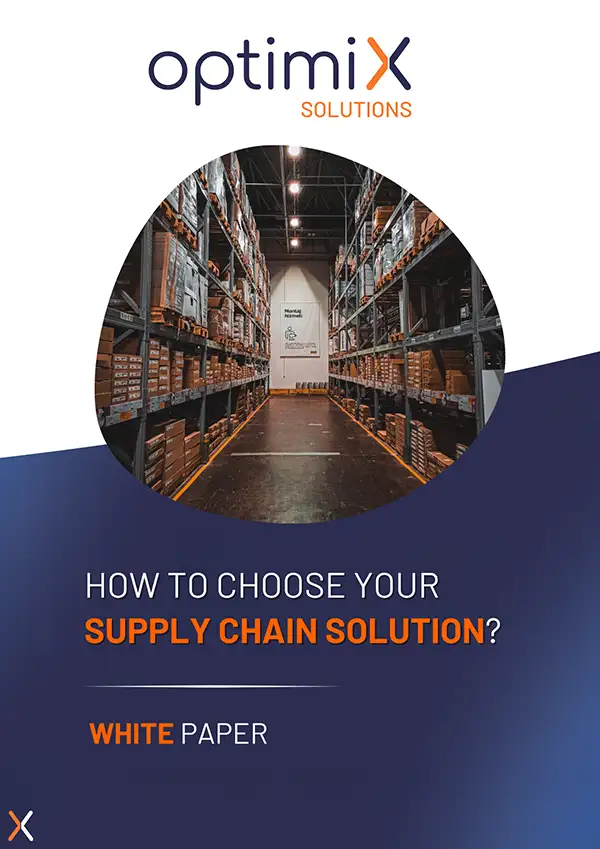Opting for a new IT software package, especially in the supply chain, can seem daunting because of the scale of the human and financial investment required.
The question then becomes how to ensure the right choice and a rapid, solid return on investment. It is essential to consider the expected benefits against the associated costs in order to effectively assess ROI.
This article offers a practical guide to identify the main value drivers, distinguish between essential functionalities from those that are secondary, and define precise objectives for implementation.
This approach not only facilitates internal communication, but also fosters the commitment of the company and its management to the project.
Supply Chain software & industry
Supply chain management software has been adopted by various sectors to improve efficiency, reduce costs and increase transparency and control of logistics operations.
Retail & Grande Distibution
In retail, logistics solutions make it possible to monitor stock levels, optimize logistics flows and track products throughout the supply chain.
These technologies enable retailers to minimize the time and costs associated with order and inventory management. What’s more, the adoption of software dedicated to the development of commercial applications contributes to improving the customer experience, boosting sales and reinforcing the overall efficiency of commercial operations.
Industrial Sector
In the manufacturing sector, supply chain management software facilitate production planning, inventory management raw materials and optimize manufacturing processes. By automating these processes, this software helps manufacturers increase their operational efficiency, enabling more agile and less costly production.
Food Distribution
For food and beverage companies, these tools enable them to streamline operationsThis guarantees fast, efficient delivery services. The use of this software also helps to optimize production, to reduce waste and maintain product qualitywhich translates into a significant improvement in sales performance.
Transport and Logistics
Logistics companies use this software to manage their entire supply chain, including transport, warehouse and inventory management. These tools enable streamline processes, reduce costs, improve customer satisfaction and increase profitability. They are beneficial for any industry involved in supply chain management or logistics, providing tools adapted to the specific complexity and dynamics of each sector.
Understanding business needs
Implementing a supply chain software solution is a complex process which requires an in-depth understanding of the company’s specific needsand a precise identification of areas for improvement.
The first step begins with a detailed analysis of internal processes, examining every stage of the supply chain, from receipt of raw materials to delivery of finished products. It’s important to identify friction points, unnecessary delays that could slow down production or increase costs. This analysis may involve direct observation of operations, interviews with field teams, or the use of data and analysis software to trace and analyze product and information flows.
Following this analysis, it is essential to to determine clear objectives for what you want to improve with supply chain solution. These objectives must be SMART (Specific, Measurable, Achievable, Realistic, Time-bound) to facilitate post-implementation performance monitoring and evaluation. Objectives could include reducing delivery times, improving inventory accuracy, or reducing transport costs.
Identification of areas for improvement
➤ Optimizing store forecasts
The automation of store sales forecasts is essential. Using machine learning algorithms, these predictive systems take into account a multitude of variables such as seasonal trends, the effect of promotions, and even the impact of external factors such as the weather. This granular approach enables more precise inventory management and better planning.
➤ Automated replenishment
Automated replenishment ensures that stores maintain optimum stock levels without frequent manual intervention. The system can be controlled by central staff, allowing in-store staff to concentrate on customer service. This process also incorporates elements such as supplier schedules and merchandising requirements.
➤ Allocation strategies
The resource allocation strategy is based on flexible models that adjust distributions according to sales forecasts, to effectively manage variations in demand and and minimize warehouse surpluses.
Maximize your ROI with Supply Chain software
Let’s take a look at the key financial benefits of implementing an effective supply chain planning system:
Sales and earnings growth
Increasing the availability of products for customers stimulates sales and, consequently, boosts profits. Better inventory management not only boosts revenues, but also optimizes profit margins by tailoring product ranges to customer needs.
Cost savings
Companies such as Procter & Gamble (P&G) are using data analysis and machine learning to perfect freight logistics, reducing shipping costs by 10-15%. and thus achieve significant annual savings. Digital adoption in supply chain management enables companies to identify inefficiencies and savings opportunities that might otherwise go unnoticed with traditional manual processes. P&G, for example, has used these technologies to fine-tune its logistics, leading to a significant reduction in transport costs by optimizing routes, load distribution and delivery schedules.
Reduced losses due to breakage
Losses due to product breakage are generally expressed as a percentage of sales, and typically vary from 1% to 4% depending on the sector. The adoption of a predictive solution using machine learning, combined with judicious replenishment enabling balance availability and risk of breakagecan significantly reduce these losses.
Continuous improvement
Supply chain management is a dynamic field that benefits greatly from the adoption of digital innovations. The continuous improvement process, supported by supply chain solutions such as Optimix XFRis not limited to initial implementation. It encourages the ongoing use of data analysis and user feedback to further optimize supply chain processes. This method ensures that the supply chain remains flexible and responsive to market trends.
Financial evaluation of supply chain projects
The investment required to develop software dedicated to supply chain management is directly linked to the functionalities it offers. Several factors influence the total cost of these customized developments, including the number of intended users, the hourly rate for software developmentas well as infrastructure requirements and support services and maintenance services.
In general, the time required to complete a project of this scale varies from seven to twelve monthsDepending on the complexity and scope of the project. The total cost of the project includes both the expenses incurred by the software publisher and those internal to the organization.
Although the development of software for supply chain management may seem economical and achievable in a short time by users, it is advisable to consult a specialized company for an accurate quotationespecially if you are considering an automated solution that will optimize your company’s operations.
Optimize your supply chain with Optimix XFR
When selecting software to manage your supply chain, it is essential to choose software that offers the right tools to improve and develop your supply chain planning at different levels of maturity. This software should also be able to create a realistic and practical business model that takes into account the specifics of your company, such as your major business challenges, specific requirements and market dynamics.
At OptimixWe work closely with our customers, supporting them every step of the way. Our aim is to help them with their digital transformation, from maximize opportunitiesto minimize risks and create added value for their business. If you’re having trouble identifying the software best suited to your needs, our team is here to help.
Contact us for a free demo and find out how we can help you achieve your goals:









